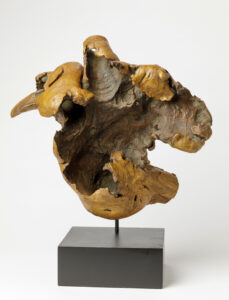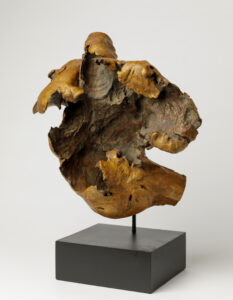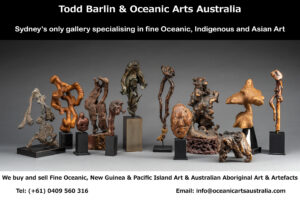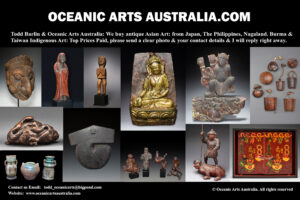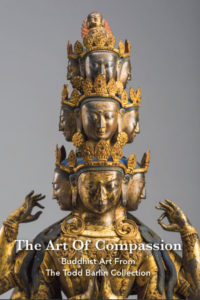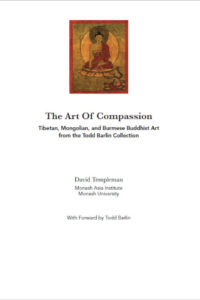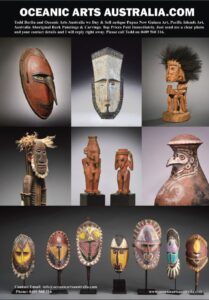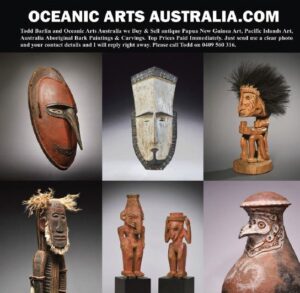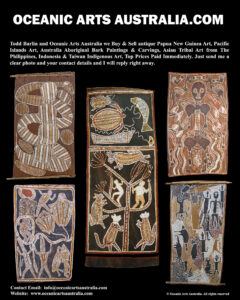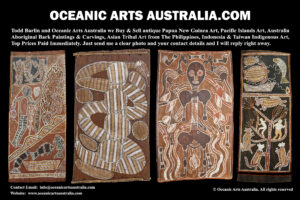A Superb Old Japanese Natural Form Burl Wood Scholars Object for Ikebana Flowers
| Collection No. | TA-550 |
|---|---|
| Size | Size 36cm x 43cm |
A Superb Old Japanese Natural Form Burl Wood Okimono or Scholar’s Object
This amazing burlwood Ikebana sculpture I thought looks like a Deer’s head, and I always called it the “Nara Deer” after the famous deer that roam free in the ancient city of Nara near Kyoto. It takes an expert’s eye to recognise the beauty and potential of root and burl treasures that are found in the wild, and skilled artisans then transform these natural wonders into functional and unique works of art
Natural arrangements for trays of this type, according to the nageire, or thrown in, style of flower arranging, is recognized as a certain stylistic category of Kado which had its origin in early ‘Buddhist flower offerings, (kuge).
Kado and Ikebana are technically the same, however, the term Kado refers not only to the beauty of the flowers but also requires manners, techniques, mental and physical training as well.
It is said that Buddhism was officially introduced to Japan around the middle of the 6th century. In Buddhism, there is a ritual of offering flowers to Buddha called “kuge,” and it is believed that this culture greatly influenced the origin of Kado.
In addition, in the ancient Japanese belief in the worship of gods, later called Shinto, there was the notion that trees were inhabited by divine spirits. Combined with this fundamental belief, the custom of offering flowers to the gods and Buddha is thought to have been accepted as natural.
The oldest style of Ikebana and the founder of Kado, is the Ikebana school in Kyoto. The origin of Ikebana is said to lie in the flower offerings made by the monks of Shiyunsan Johoji Temple in Kyoto. The priests of Ikebana offered flowers to Nyoirin Kannon the Buddhist Bodhisattva Avalokiteśvara
Kado is the art of arranging flowers, plants, and trees. There is a systematized aesthetic sense and theory of layout that has been handed down since ancient times. The names and ideas differ slightly from school to school, and the complex principles involved are difficult to outline in a single sentence, but let us touch on a few principles.
First of all, Kado artwork is characterized by the fact that the direction in which it is viewed is basically fixed. Unlike flower arrangements, which can be viewed from any direction, ikebana works must be placed in a “tokonoma,” or alcove. Therefore, ikebana has a “front” that should be appreciated. Also, because flowers, plants, and trees are natural objects, no single piece of ikebana can be perfectly symmetrical.
The way of arranging flowers also expands infinitely depending on assumptions such as the combination of seasons, colour schemes, and the types of flowers to be used.
This is a Wabi-Sabi Okimono that may have been used in tea ceremonies for Ikebana Flower Displays
In Zen philosophy there are seven aesthetic principles for achieving Wabi-Sabi as listed below;
Fukinsei (不均斉): asymmetry, irregularity;
Kanso (簡素): simplicity;
Koko (考古): basic, weathered;
Shizen (自然): without pretence, natural;
Yugen (幽玄): subtly profound grace, not obvious;
Datsuzoku (脱俗): unbounded by convention, free;
Scholars’ objects were, in a sense, the luxury goods of their time, but rather than wealth, what they really represented was the physical embodiment of the scholar’s intellectual curiosity and aesthetic taste.
Provenance: The Todd Barlin Collection of Japanese Art & Objects & Asian Art & Objects. Please look at my collection of Japanese Inro & Smoking Pouches & other Japanese art objects on my website.
See more Fine Japanese Art in Japanese Art Gallery
See my new EXHIBITIONS GALLERY showing the Museums and Art Galleries Exhibitions that I provided artworks for over the past 40 years. There is the link to the article about my artworks published in the prestigious Louvre Magazine in 1996
I have artwork for Museums and art Galleries but also for collectors at every stage of their collecting. I want to encourage people to explore the fine art of New Guinea & West Papua and the Pacific Islands and to be able to see and touch the artworks in a relaxed and friendly manner in my Sydney Gallery. I would like to invite you to visit my gallery and see the artworks in person and also look at my website www.oceanicartsaustralia.com where there are many Galleries & Sub Galleries to explore.
My Gallery of nearly 40 years is the last physical gallery in Sydney that specializes in New Guinea and Oceanic Art. Sydney is very close to New Guinea & the Pacific Islands where all of these amazing artworks came from, Australia’s closest neighbours.
To see many more rare items and the finest masterpieces, please make an appointment with us to visit the gallery.
For all inquiries, please contact us

